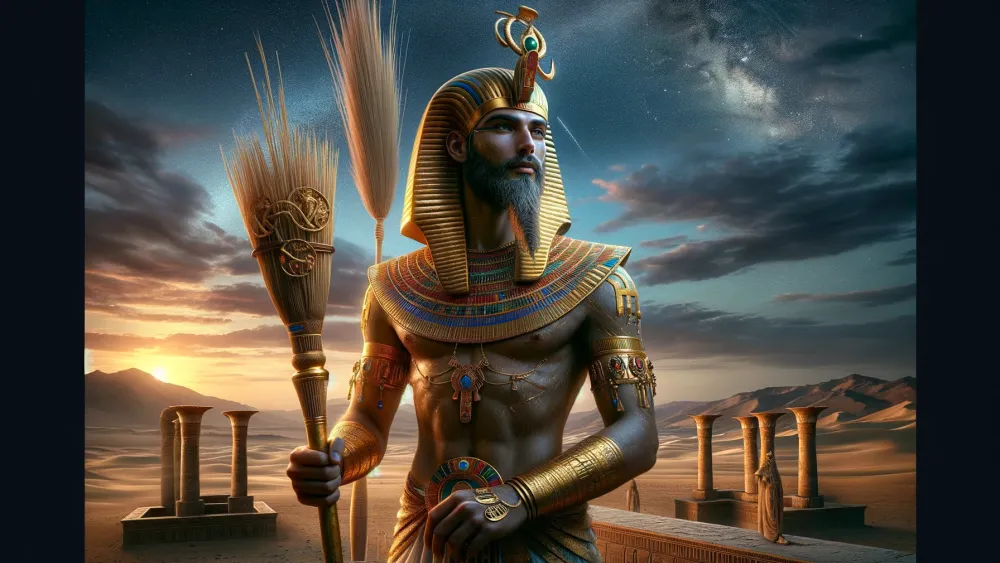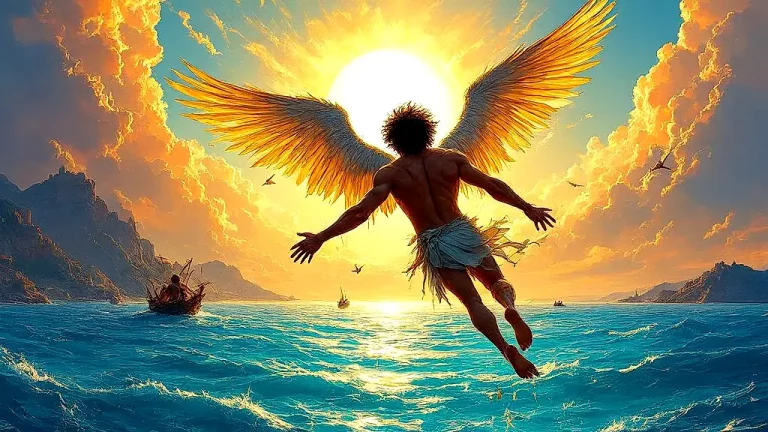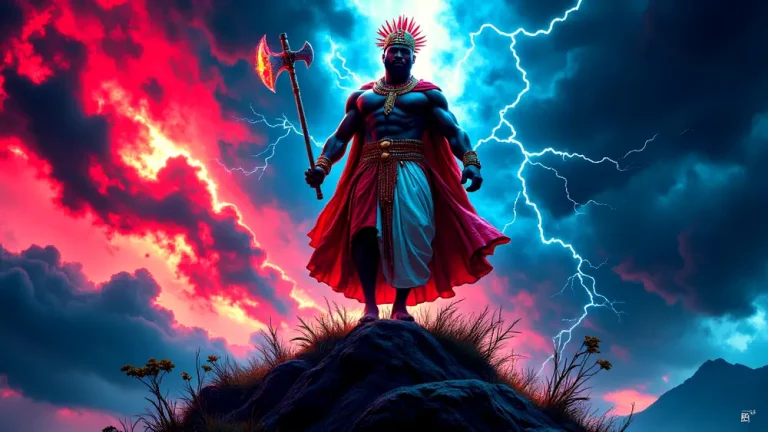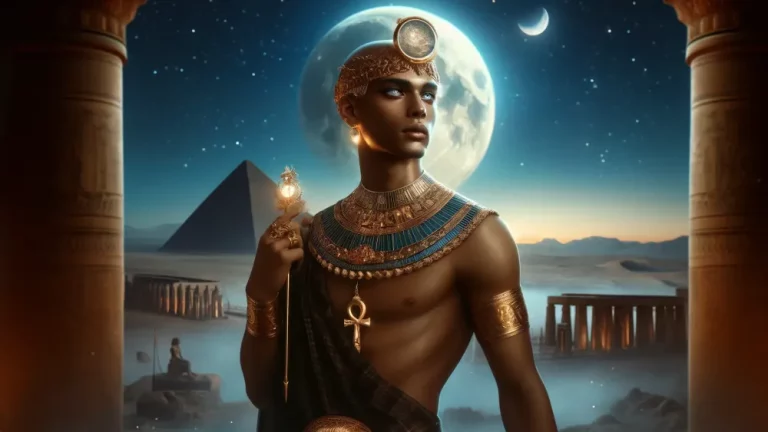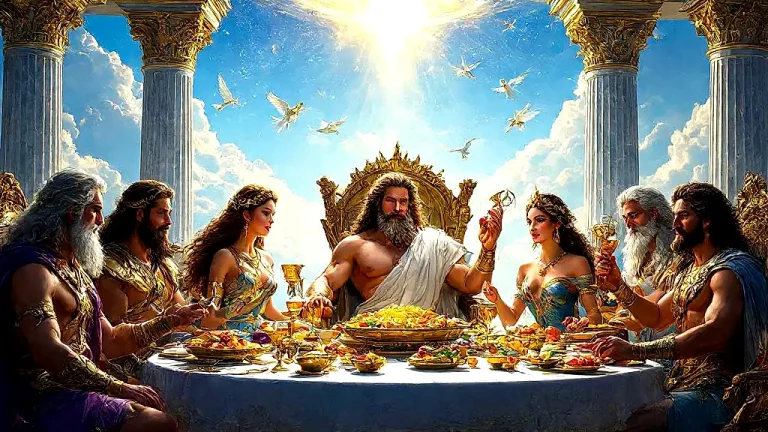Heh: Ancient Egyptian Deity Of Infinity And Eternity
In the big story of ancient Egyptian mythology, few gods capture the ideas of infinity and eternity like Heh. Often shown with symbols that go beyond time, Heh stands for the endless and forever. This god plays a big part in Egypt’s religious world. This blog post looks into where Heh comes from, what he symbolizes, and his lasting impact.
Key Points:
- Heh is an ancient Egyptian deity symbolizing infinity and eternity.
- Heh is part of the Ogdoad of Hermopolis, a group of eight primordial gods.
- Heh is often represented with symbols like the frog and the palm frond.
- Heh’s influence is seen in creation myths and worship practices in ancient Egypt.
- Heh’s symbols and themes still inspire modern culture and spiritual practices.
- Heh’s legacy endows Egyptian mythology with ongoing fascination and relevance.
We explore how people honored him through history by checking out old texts, artifacts, and modern takes on him. By digging into these layers, we aim to show why Heh is such an interesting figure among Egyptian gods.
Heh: Overview and Key Facts
| Aspect | Details |
|---|---|
| Name | Heh (also spelled Huh or Hah) |
| Role | God of infinity and eternity |
| Symbolism | Stands for boundlessness, eternal life, and the infinite |
| Iconography | Often shown with a frog’s head or holding a palm frond |
| Associated Symbols | Frog, palm frond, shen ring (symbol of eternity) |
| Mythological Group | Part of the Ogdoad of Hermopolis |
| Female Counterpart | Hauhet, who also stands for infinity |
| Earliest Mentions | Found in Pyramid Texts and Coffin Texts |
| Cultural Significance | Key to creation myths and the idea of eternal life |
| Worship Practices | Involved in rituals aimed at invoking eternal life and order |
| Artistic Depictions | Seen in temple carvings, tomb paintings, and various artifacts |
| Influence on Myths | Impacts later gods and stories by symbolizing the cosmos’ eternal aspect |
| Modern Legacy | Still interests people today in literature, art, and media |
The Origins of Heh
To get why Heh matters, we need to see where he starts. Let’s explore his beginnings in Egyptian mythology.
The Birth of Heh in Egyptian Mythology
The earliest mentions of Heh show up in ancient texts like the Pyramid Texts and Coffin Texts (from the Old Kingdom and Middle Kingdom periods). These texts often describe Heh as a god who stands for infinity and eternal life. For instance, Heh usually holds a palm frond (a symbol of long life) and a shen ring (a symbol of eternity).
These symbols help explain his role in how Egyptians see the universe. In these early writings, Heh isn’t just on his own but part of a bigger mythological story that includes other gods representing key parts of existence. Heh’s rise in Egyptian mythology happens within a rich cultural and religious setting. Ancient Egyptians focus heavily on the afterlife and the soul’s eternal nature.
Consequently, gods like Heh, who stand for infinity and eternity, become very important. In particular, Heh is part of the Ogdoad of Hermopolis (a group of eight gods who represent creation’s basic elements). This group has four male-female pairs, each showing different aspects of chaotic waters from which everything comes. For example, Heh and his female counterpart Hauhet symbolize these waters’ infinite nature.
This context shows how deeply connected Heh’s role is with the Egyptian view where eternity and infinity are central to understanding life.
- Earliest mentions in Pyramid Texts.
- Symbols: palm frond, shen ring.
- Part of Ogdoad.
- Represents infinity in creation myths.
Heh represents infinity and eternal life in Egyptian mythology, symbolized by a palm frond and shen ring, and is a key figure in creation myths as part of the Ogdoad.
Heh and the Ogdoad of Hermopolis
The Ogdoad of Hermopolis is a group of eight gods in ancient Egyptian beliefs. These gods stand for the basic elements that existed before the world began. The Ogdoad includes four male-female pairs, each showing different parts of the chaotic waters from which everything comes. For example, Nun and Naunet represent the watery abyss, while Amon and Amaunet stand for hiddenness.
The Ogdoad plays a big role in Egyptian cosmology because it explains how the universe started and what forces shape it. In this way, people use the Ogdoad to understand where everything came from. Heh’s job within the Ogdoad is to show infinity and eternity. Heh and his female counterpart, Hauhet, symbolize these endless waters’ boundless nature.
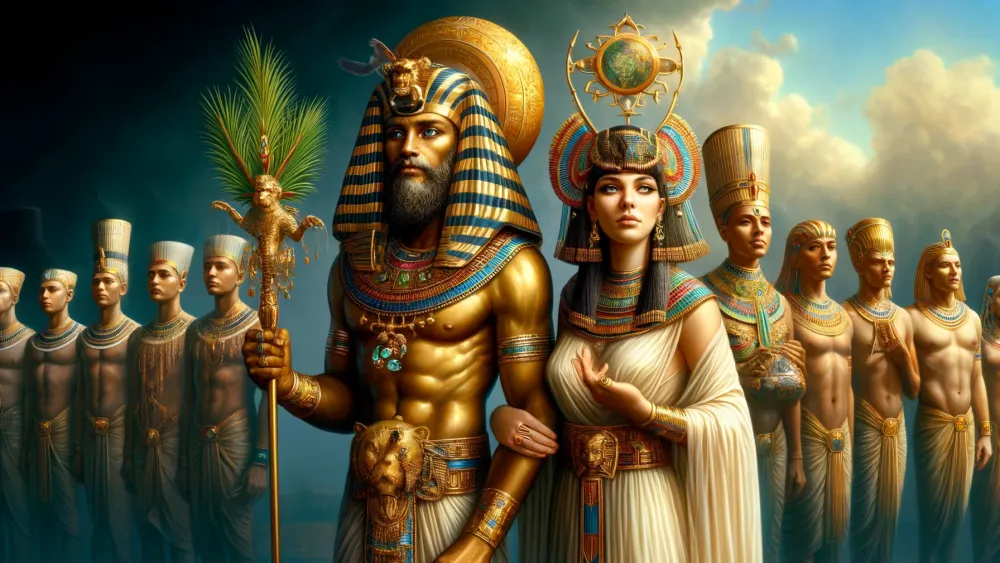
In particular, Heh often holds a palm frond and a shen ring (both symbols of eternal life). These symbols highlight his role in representing never-ending aspects of existence. As a result, Heh and Hauhet’s place in the Ogdoad shows how important infinity is in Egyptian creation stories.
For instance, their presence shows Egyptians see the universe as an eternal cycle with no start or end.
| Deity Pair | Symbolism |
|---|---|
| Nun and Naunet | Watery abyss |
| Amon and Amaunet | Hiddenness |
| Heh and Hauhet | Infinity and eternity |
| Kuk and Kauket | Darkness |
Symbolism and Iconography of Heh
Given that Heh’s role in the Ogdoad is so important, his symbols and images carry deep meaning. For instance, let’s explore what these symbols tell us about infinity and eternity.
The Symbol of Infinity: Heh’s Iconography
Heh often shows up with symbols like the frog and the palm frond. The frog, in ancient Egyptian culture, stands for fertility and rebirth because frogs appear in large numbers after the Nile floods. In this way, the frog connects to endless cycles and renewal. Meanwhile, the palm frond is another key symbol. Ancient Egyptians use palm fronds to count years, so they become a sign of long life and eternity.
For instance, Heh often holds a palm frond with notches (each notch represents a year), which highlights his link to endless time. These symbols help explain how Heh represents infinity and eternity. For example, the frog’s connection to rebirth and cycles shows how life continues without end. At the same time, using palm fronds to mark years highlights time stretching on forever.
As a result, these symbols together paint a picture of Heh as a god who embodies never-ending time and existence. In particular, they show how ancient Egyptians view the universe as an eternal cycle, with Heh playing a key role in this endless process. Key Symbols of Heh:
- Frog: Stands for fertility and rebirth.
- Palm frond: Represents long life and eternity.
Heh symbolizes infinity and eternity through the frog and palm frond, which represent cycles of life and endless time.
Artistic Depictions of Heh in Ancient Egypt
Heh shows up in many forms in ancient Egyptian temples and tombs. Temple carvings often show Heh holding a palm frond and a shen ring (a circle symbolizing eternity). Tomb paintings usually place him alongside other gods, highlighting his role in the divine order. In particular, these images stress his link to infinity and eternal life.
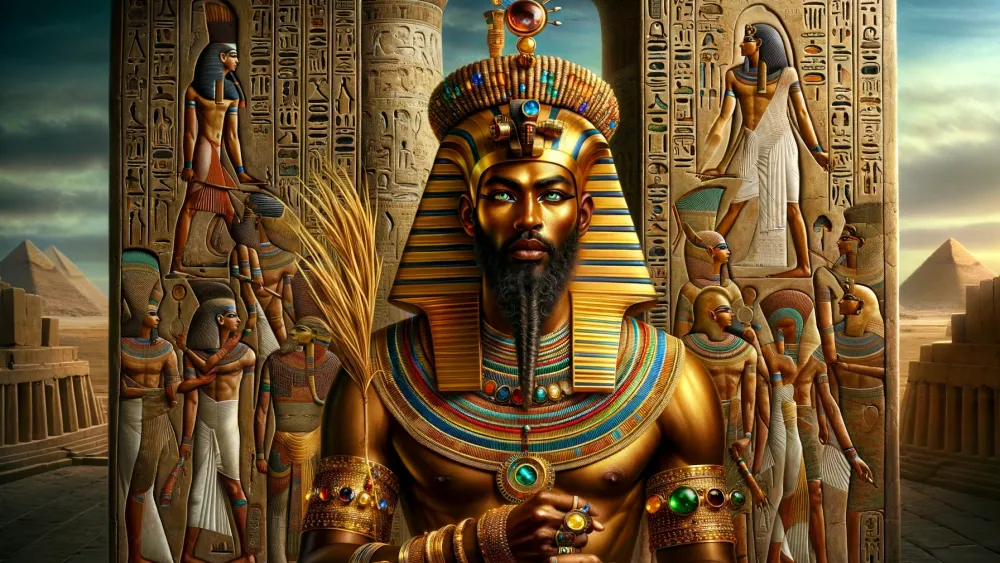
As for materials, artists carve Heh into stone or paint him on walls using bright colors. These artistic depictions help us see how ancient Egyptians view Heh and his importance. Different styles and periods show changes in how artists depict Heh. For example, during the Old Kingdom (around 2686–2181 BCE), images of Heh are simpler with fewer details.
On the flip side, in the New Kingdom (around 1550–1070 BCE), artists use more intricate designs and add more symbols to his depictions. At the same time, regional differences also matter. In particular, Upper Egypt might show Heh with different features compared to Lower Egypt’s versions.
Eventually, these variations reflect changing art styles and religious practices over time, giving us a richer understanding of Heh’s role in ancient Egyptian culture.
Heh’s Role in Egyptian Religion
Given Heh’s rich symbols and art, he clearly holds a special place in Egyptian religion. Next, let’s dive into how Heh fits into creation myths and worship practices.
Heh in Creation Myths
Heh plays a big role in the creation myths of ancient Egypt. For instance, in the Ogdoad of Hermopolis (a group of eight primordial gods), Heh stands for infinity and endless time. As a result, Heh sets the stage for creation by embodying endless potential. His presence ensures that creation and renewal go on forever.
Meanwhile, his symbols (like the frog and palm frond) stress his link to eternity. Heh’s relationship with other creator gods like Atum and Ra is also key. For example, Atum (the god of creation) uses the infinite potential that Heh represents to bring forth the universe’s first elements.
Ra (the sun god) shows the daily cycle of birth, death, and rebirth, tying back to Heh’s idea of endless time. Consequently, Heh complements these gods by providing an infinite backdrop for creation. This relationship shows how ancient Egyptians see the universe as a balance between finite and infinite forces.
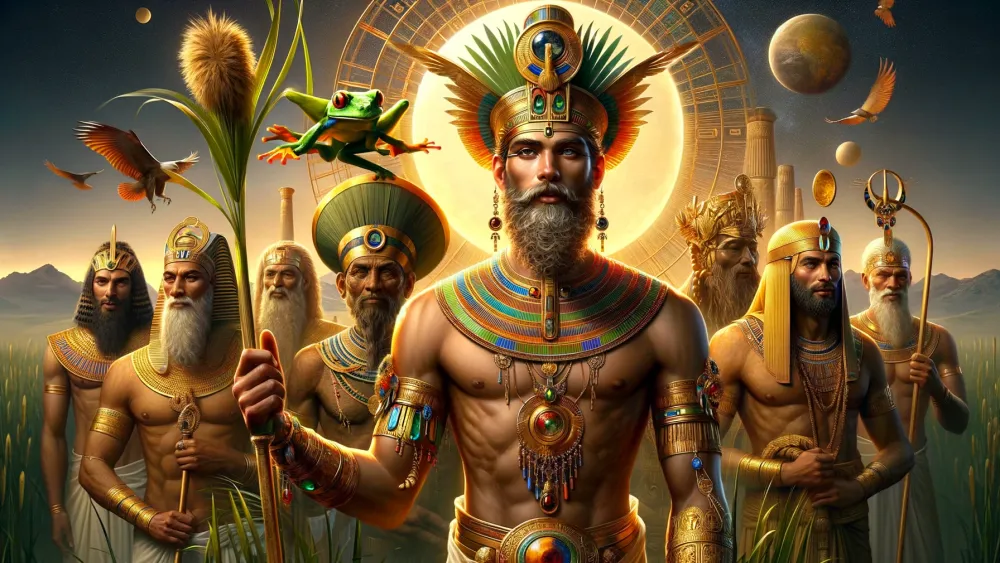
- Heh stands for infinity in creation myths.
- He helps Atum create the universe.
- He complements Ra by showing endless time.
Rituals and Worship Practices Involving Heh
Rituals and ceremonies for Heh often focus on eternity and endless time. For instance, Egyptians might perform special rites during the New Year to honor Heh, symbolizing the endless cycle of time. In particular, these rituals could include offerings of food, drink, and symbolic items like palm fronds (which stand for long life). Priests recite hymns and prayers to ask for Heh’s blessings for eternal prosperity.
As for locations, these ceremonies usually happen in temples dedicated to the Ogdoad or special shrines within larger temple complexes. Priests and worshippers play key roles in these practices. For example, priests act as go-betweens for Heh and the people, performing rituals and keeping sacred spaces clean. At the same time, worshippers bring offerings and join communal prayers.
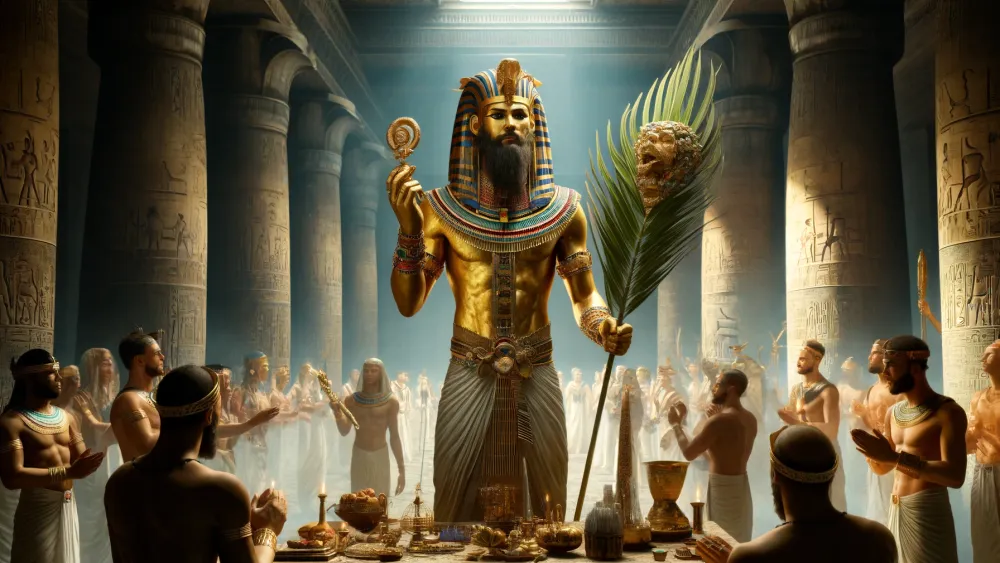
This creates a shared experience that strengthens their bond with the divine. Special festivals might involve processions where statues of Heh are carried through streets so everyone can take part in worship. Eventually, these practices help keep belief in Heh’s eternal influence alive among the people.
Heh’s Influence on Other Deities
Given that Heh ties deeply to infinity, his influence touches many other gods. Understanding Heh shows how these connections shape Egyptian mythology.
Connections Between Heh and Hauhet
Heh and his female counterpart, Hauhet, form a pair that stands for infinity. While Heh shows the male side of infinity, Hauhet represents the female side. Their place in the Ogdoad (a group of eight primordial gods) highlights balance between male and female forces. Furthermore, Heh and Hauhet together show endless cycles and eternal renewal.
As for their symbols, Heh often has a frog’s head, while Hauhet has a snake’s head (both animals linked to creation). Their partnership underscores that infinity needs both male and female energies to keep the universe going.
Pantheon of All the Egyptian Mythology Gods
The Egyptian pantheon includes many gods and goddesses. For instance, Ra, the sun god, and Osiris, the afterlife god, play big roles in myths. At the same time, goddesses like Isis and Hathor are very important too. Given that there are so many deities, it can be hard to remember them all. For a full overview, you can check out this list of all Egyptian gods.
In particular, this list covers both major and minor gods, giving a complete picture of Egyptian mythology.
FAQs
1. Who is Heh in Egyptian mythology?
Heh in Egyptian mythology is the deity representing infinity and eternity.
2. What symbols are associated with Heh?
Symbols associated with Heh include the frog and the palm frond, both representing infinity and eternity.
3. How was Heh worshipped in ancient Egypt?
Heh was worshipped in ancient Egypt through rituals and ceremonies conducted by priests and worshippers who venerated him as a deity of infinity and eternity.
4. What is the significance of Heh in creation myths?
The significance of Heh in creation myths lies in his representation of the infinite and eternal aspects of the universe.

